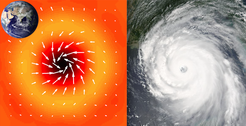Giant Hurricanes on the Sun
World experts in solar physics gather in Göttingen to discuss new results from NASA’s Solar Dynamics Observatory.
From the 1st to the 5th of September 2014, 70 scientists from all over the world will gather at the Max Planck Institute for Solar System Research (MPS) in Göttingen for the international conference “Helioseismology and Applications”. Helioseismology is the use of the Sun’s acoustic waves to probe the interior of the Sun. One of the conference’s exciting topics is the recent discovery of giant spiraling hurricanes on the Sun.
Among the many world experts in helioseismology to attend this event, Dr. Thomas Duvall Jr., winner of this year’s prestigious Hale Prize, will address the audience. Dr. Duvall has worked for many years at NASA in the USA and will commence a professional appointment at the MPS this September.
The focus of the meeting is to discuss new results from NASA’s space-based Solar Dynamics Observatory (SDO). Since its launch in 2010, the instrument has delivered 1.5 Terabytes of data per day, in the form of 4096 x 4096 pixel images of the full visible disk of the Sun. Scientists in Göttingen have direct access to this high quality data, which are transferred automatically from Stanford, California to the German Data Centre for SDO at the MPS, a unique European facility funded by the DLR.

Taking full advantage of having this treasure-chest of data at his fingertips, doctoral student Jan Langfellner of the International Max Planck Research School for Solar System Science, together with Prof. Laurent Gizon and Dr. Aaron Birch, have detected the subsurface swirling motions of thousands of gargantuan ‘hurricanes’ all over the Sun.
On Earth, hurricanes are caused by low pressure systems combined with effects of the Earth’s rotation, which dictates the direction of the spiralling pattern. In the northern hemisphere hurricanes rotate anti-clockwise, and clockwise in the southern hemisphere.
On the Sun, hot plasma wells up from the hot interior like in a pot of boiling water. At the surface, the plasma cools and sinks back into the interior. Each such motion of rising, cooling, and sinking is called a convection cell and the largest convection cells span several tens of thousands of kilometers. The Sun rotates with a period of 27 days. Spiralling ‘hurricanes’ on the Sun are caused by the effect of the Sun’s rotation on these large convection cells. These hurricanes are close to three times the size of the entire Earth and also rotate in opposite directions on either side of the solar equator, albeit at a slower speed of about 50 km/hr compared to 200 km/hr on Earth. Because of their slow speeds it requires many days of SDO observations to observe this phenomenon.
These, and many other exciting results, will be presented at the meeting, opening a new window to our understanding of the global dynamics of the Sun, exposed by these wondrous discoveries. MPS Director and University professor, Prof. Laurent Gizon, who is hosting the conference emphasises that “this is the golden age of helioseismology, when we have access to the highest resolution observations, every minute of every day for over four entire years. With this data we are able to reveal the subtle, hidden secrets of the Sun.”
